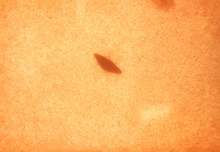Streptococcus salivarius
| Streptococcus salivarius | |
|---|---|
 | |
| Colony of Streptococcus salivarius on blood agar | |
| Scientific classification | |
| Domain: | Bacteria |
| Phylum: | Firmicutes |
| Class: | Bacilli |
| Order: | Lactobacillales |
| Family: | Streptococcaceae |
| Genus: | Streptococcus |
| Species: | S. salivarius |
| Binomial name | |
| Streptococcus salivarius Andrewes & Horder 1906 | |
| Synonyms | |
|
Streptococcus salivarius subsp. thermophilus Andrewes & Horder 1906 | |
Streptococcus salivarius is a species of spherical, gram-positive, facultative anaerobic bacteria that is both catalase and oxidase negative. S. salivarius colonizes (usually in chains) the mouth and upper respiratory tract of humans just a few hours after birth, making further exposure to the bacteria harmless in most circumstances. The bacteria is considered an opportunistic pathogen, rarely finding its way into the bloodstream, where it has been implicated in cases of sepsis in people with neutropenia, (a deficiency in white blood cells).
S. salivarius has distinct characteristics when exposed to different environmental nutrients. For example, in the laboratory, if a growth medium is used that includes sucrose then S. salivarius is able to use the sucrose to produce a capsule around itself. However, if sucrose is replaced by glucose as on a GYC (glucose, yeast extract, calcium carbonate) plate, S. salivarius is unable to make a capsule from the glucose.
More importantly, in the laboratory, S. salivarius can show a distinct clearing on GYC plates. This is because S. salivarius can ferment the glucose yielding lactic acid. Next, the lactic acid actually reacts with the calcium carbonate in the GYC plate, resulting in zones of clearings on the plate.
Role as a probiotic
Some strains of S. salivarius are being trialed for their use as a probiotic in the prevention of oral infections. Some strains of S. salivarius are found to produce BLIS (Bacteriocin-like Inhibitory Substances) which are antimicrobial peptides. These peptides display interspecies inhibition, and inhibit Streptococcus pyogenes (which causes Strep throat infections). Lozenges containing S. salivarius are marketed to support immunity against more virulent Streptococcus strains. People with this strain of naturally occurring S. salivarius on their tongue have been shown to have fewer Strep throat infections.[1] This is also being investigated for its potential to prevent rheumatic heart disease which is also caused by S. pyogenes.
Agglutination of Streptococcus salivarius is often used in the diagnosis of atypical pneumonia caused by Haemophilus influenzae
Subspecies
Streptococcus salivarius subsp. thermophilus, also known as Streptococcus thermophilus, is a subspecies of S. salivarius.
References
- ↑ Wescombe, P. A.; Heng, N. C. K.; et al. (2009). "Streptococcal bacteriocins and the case for Streptococcus salivarius as model oral probiotics". Future Microbiology. 4 (7): 819–835. doi:10.2217/fmb.09.61.
Further reading
- Barbour A, Philip K (June 18, 2014). "Variable Characteristics of Bacteriocin-Producing Streptococcus salivarius Strains Isolated from Malaysian Subjects". PLoS ONE. 9 (6): e100541. PMC 4062538
 . PMID 24941127. doi:10.1371/journal.pone.0100541.
. PMID 24941127. doi:10.1371/journal.pone.0100541. - Huang, Szu-Chuan; Burne, Robert A.; Chen, Yi-Ywan M. (September 2014). "The pH-Dependent Expression of the Urease Operon in Streptococcus salivarius Is Mediated by CodY". Applied and Environmental Microbiology. 80 (17): 5386–5393. doi:10.1128/AEM.00755-14.
- Kaci, Ghalia; Goudercourt, Denise; Dennin, Véronique Dennin; Pot, Bruno; Doré, Joël; Ehrlich, S. Dusko; Renault, Pierre; Blottière, Hervé M.; Daniel, Catherine; Delorme, Christine (February 2014). "Anti-Inflammatory Properties of Streptococcus salivarius, a Commensal Bacterium of the Oral Cavity and Digestive Tract". Applied and Environmental Microbiology. 80 (3): 928–934. PMC 3911234
 . PMID 24271166. doi:10.1128/AEM.03133-13.
. PMID 24271166. doi:10.1128/AEM.03133-13.
External links
- Streptococcus salivarius, UniProt
- Type strain of Streptococcus salivarius at BacDive - the Bacterial Diversity Metadatabase